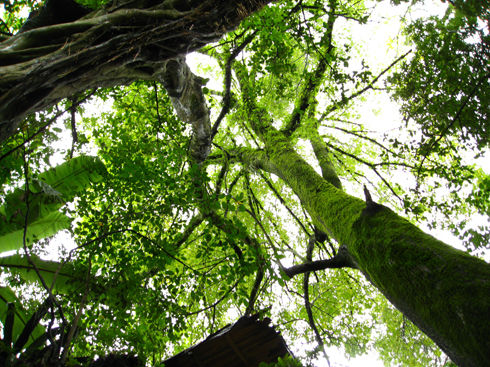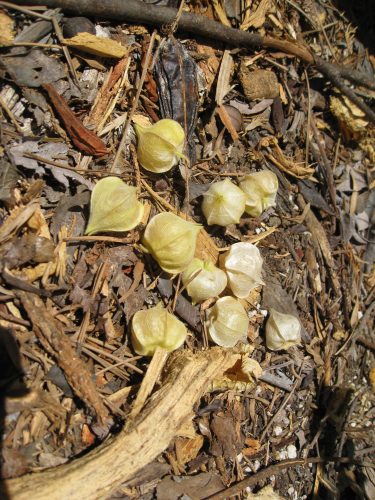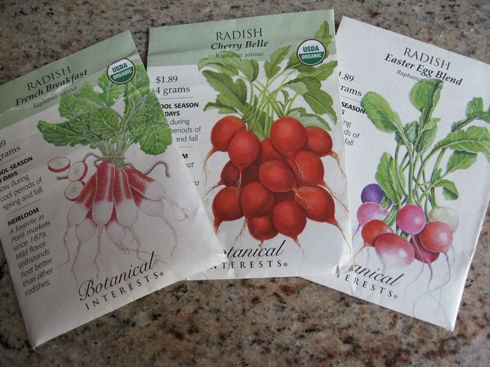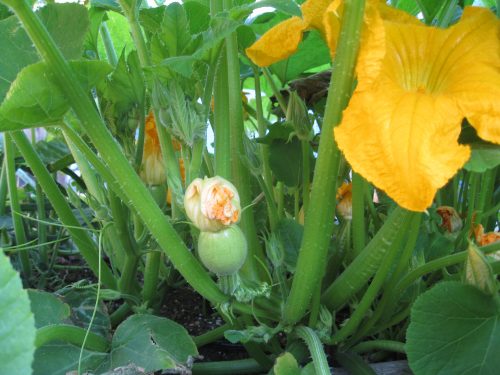The mailbox of Ask Gardenerd has been receiving some great questions this week. Here’s another about the difference between moss and moss:
“A question about moss… What is the difference between
peat moss, sphagnum moss, and the green moss that grows around the
ground? Going into the 3rd year with my raised bed, and it has many
patches of green moss. Is this detrimental to the plants? Should it be
removed or turned back under into the soil? Thanks in advance. Judy”
I love this question, thanks for writing in. There is a difference in the functionality of these different mosses, and it’s good to know which is which, so you can use them properly.

Mossy trees in Mexico’s National Park in Uruapan
Peat Moss – Technically called Sphagnum Peat Moss. This is the stuff you see most often in bags at the nursery, sold as a soil amendment. It is comprised of decaying material harvested from bogs. It is the dead material underneath the living part of the plant (we’ll talk about that in a second).
These bogs take between one to three thousand years for nature to make them, and we harvest the contents much faster than that. The world is experiencing a dramatic loss of peat bogs, between 89-98% of the bogs that once existed are now gone. That’s why I recommend using coir, the outside hull of coconuts (which is a waste product) instead.
Sphagnum Moss – This is also found at nurseries or craft and hardware stores, and is used to line hanging baskets. It’s often used to cover the soil in decorative topiaries. This is the living part of the plant that dwells above ground. It covers the bog and without it the bog can not thrive. This part is usually removed in order to access the peat below, though many countries have adopted sustainable harvesting methods to preserve the sphagnum layer while still accessing the decaying peat below.
Sphagnum moss can contain some pretty nasty fungal spores, which if not handled properly (or sterilized before being sold) can get under your nails and cause major health issues. It is recommended to use gloves when handling decorative sphagnum moss.
That other moss – Green moss or algae (and it could be either) that appears on the soil surface usually crops up in places where soil has poor drainage and more shade. In reading about the possibilities, I came across this helpful guide from University of Georgia:
Controlling Moss and Algae in Turf
To summarize this and other sources of info, here are a few tips:
It’s generally harmless – you can scratch the soil surface to disperse it, and it will most likely come back, but it won’t harm or kill your plants.
Check soil pH and fertility – algae tends to grow in infertile areas where there is light, so check your soil and amend with organic fertilizer as needed. Add lime if the soil is too acidic (another happy breeding ground for algae).
Add compost – to improve drainage, or create raised beds.
Cut back on watering – the presence of algae or moss is a sure sign that the soil is too wet. Let the soil dry out between waterings if possible and see if that doesn’t improve things.
Thanks for writing in. I hope this helps.




I live in an area where live sphagnum moss grows everywhere and is readily available for harvest – while I understand its not the same as peat moss, I am wondering if I’d be able to use this in a similar way in my garden after drying and shredding it? Or even if left green? Not so much for the drainage/water retention properties typically sought with peat as the addition of organic material to improve the condition of the soil? Your mention of fungal issues (which I hadn’t heard of before) now has me somewhat worried!
It’s really not the same thing. I’m not sure what the pH of it is (which is often why peat is used – to lower soil pH) and it can harbor pathogens that can cause trouble down the line. I’d suggest doing a lot more research before using sphagnum as a substitute for peat.
can you use green moss that grows on top of soil as sphagnum moss in ammending soil to grow plants in? Will it continue grow?
I wish I knew the answer to that, Judy, but I imagine it might be challenging to grow that kind of moss outside of its natural environment. Anything is worth a try, I always say.
Sorry wrong spelling. To clarify..Can sphagnum moss be used as ground cover, inside pots in the back yard as well as inside the home to cover soil inside the posts.
Is this a good thing to do or no? Please clarify. Thanks in advance.
Daisy, Sphagnum moss can be used as a cover on top of plants. In fact, it’s used a lot for that purpose. The stuff you buy in a bag is usually sterilized to prevent those pathogen issues, so if you plan to use home-grown moss indoors, you may want to dry it out well and disinfect first before bringing it indoors.
My research online about spagnum moss and it’s use are with caution pertaining to fungus etc while other articles have no mention of this. Can I use spagnum moss from my oak tree in Florida and use them are indoor pot ‘ground cover’ to maintain moisture and also to hid the soil?
I understand the reasoning for using coir. But since it’s a waste product, why does it cost so much more?
It still does have to be processed to remove the salts, and to ship around the globe. As with many natural resources (ie. peat, gas, oil, etc) they appear to be cheaper, but we pay for them in the long run when either we use them up or from the pollution caused during extraction. The cost of those externalities are often hidden, but with reusable and waste products we see the costs for the whole thing.
I am planning on making succulent bowls, I’m not sure what would be best for the plant. Peat moss or sphagum moss. Any thoughts?
For decorative purposes, use sphagnum moss. For planting use a cactus mix. That usually has the right balance of organic material for succulents.
The soil in my raised beds had a high ph of 8 so I added sphagnum peat moss to the beds in a effort to lower the pH since I was growing watermelons and they do not like a high acid soil and the melons were getting blossom end rot. Is that o.k.?
HI Mary, you can add peat moss to your soil and it may lower the pH a bit, depending on how much you add. You might want to throw in some Epsom salts to help with calcium uptake (calcium deficiency is the root cause of blossom end rot in most cases). Keep an eye on the soil pH because sometimes a little input goes a long way. Add compost and that will help regulate pH as well. Keep us posted.
Here in Minnesota and Wisconsin we do harvest Sphagnum moss is a sustainable way. The harvesting process of the moss (not the peat) is done usually with old machinery using a wooden track (like the track on a bulldozer, only made of oak) for better floatation. The harvesting process spreads innumerable spores that quickly take hold after the harvest. The moss grows back to its original thickness rather quickly (8-10 yrs.) Now, compare that to even the fastest growing trees (e.g. Quaking Aspen) which take several decades to mature, according to the University of Minnesota Agro Forestry Dept.
Thanks for sharing, Steve. I’m glad to hear Minnesota and Wisconsin are harvesting sustainably.
Great to know this information. I will be using COCONUT COIR in the future.
In Canada, it has been estimated that new peat bog mass accumulates 60 times faster than the amount harvested each year. Approximately .02 percent of the 270 million acres (422,000 square miles) of Canadian peat bog are used for peat moss mining.[
Hi,
I bought a big cube of sphagnum moss which is labeled from Independence, OR.
I am planning to break this up and add to the soil in my very small vegetable garden.
IS THIS a bad plan? Maybe I have made a mistake buying this moss?
Hi John,
Look for the word “peat” because that’s what you want to add to your garden. Sphagnum moss is generally used in crafting and as a top layer over potted plants or hanging baskets. Peat moss is what is used to amend garden soils. If you add sphagnum moss to your garden it probably won’t cause any damage, but it may not have the effect you’re hoping for. In the future, we recommend using coconut coir instead of peat moss. It’s a waste product instead of a not-quite-renewable resource. Keep us posted on how thing go.
Its a bit confusing to be honest.
my plants at home consist of yukkas, 2 majestic palms, 1 bird of paradise.and 2 cordylines.
Inside i have a small birds nest tree fern.
All i have used is peat miss mixed with potting mix for the birds nest fern.
As for outside…..no peat moss or sphagnum moss.
All plants have been repotted and fertlised as its the start of summer here in australia.
I am considering putting a layer of sphagnum moss on top of my small palms to keep the moisture in the soil underneath.
My question is……can i use a mixture of premium potting mix with peat moss AND also have a layer of sphagnum on the top (about 2 inches) ?
Or you can only use 1 or the other ?
Beneficial using both as palms like a good drink amd the peat will be excellent for that.
Or the sphagnum top layer will also keep the moisture in so it doesnt need watering everyday during summer.
Any ideas anyone ?
I can try and post pictures of what i have.
I wish I could help you Brendan, but I don’t use peat moss because of its environmental impact) and I’m not a pro on palm trees. I would much prefer to mulch with leaf litter or chip bark, both of which are waste products and nature made them to shed naturally. Perhaps someone here can post a suggestion specifically about peat.
I have purchased two staghorn ferns and it is recommended to plant them in sphagnum moss. I have checked my local garden centers and they only have the sphagnum peat moss. Would this product do as well?
No. Sphagnum moss and sphagnum peat moss are not the same thing (which you clearly already know :-)). Sphagnum moss is the living part of the peat bog, and it’s a product that you won’t find at most nurseries, unless they sell orchids or other decorative houseplants. Sphagnum peat moss is the dead material underneath the living part of the peat bog. That’s the stuff you’ll find at nurseries and in just about every potting soil mix on the market.
You’ll find sphagnum moss at craft stores, since it’s used most often as a decorative cover for the tops of potted plants, or as a liner for hanging baskets. It holds in soil and moisture, and in the case of your staghorn ferns, which are epiphytes (meaning they grow without soil, roots exposed to the air), it will keep the root area moist while still allowing air flow.
So check your local craft store or flower shop for sphagnum moss instead.
A big thank you. This answers my question perfectly, as well.